In this era of oversupply, the long-told “Tale of Two Industries” story that the Washington wine world presents needs to be rewritten.
“We are an industry of small wineries and a few large wineries,” said Erik McLaughlin, CEO of industry consulting firm Metis. Staying small and getting big have long been considered the safe paths, but what may be a good strategy for an individual winery may be bad for the collective industry. “We need more medium-sized wineries on the national platform to help us build brand Washington.”
McLaughlin spoke during the State of the Industry session at WineVit, the annual convention hosted by the Washington Winegrowers Association in Kennewick in February.
With fellow speakers Adam Schulz, owner of Incredible Bulk Wine Co., Liz Thach, president of the market research group Wine Market Council, and Kristina Kelley, executive director of the Washington State Wine Commission, McLaughlin painted a picture of a declining U.S. wine market and a regional industry with too many acres and too many unsold gallons acting as an anchor. Navigating those rocky shores, in McLaughlin’s analogy, may require some reinvention.
“How do we win in a declining wine market? The only solution is to take share,” McLaughlin said. “We have to position Washington wines and our individual wineries to take more of a share of a shrinking pie.”
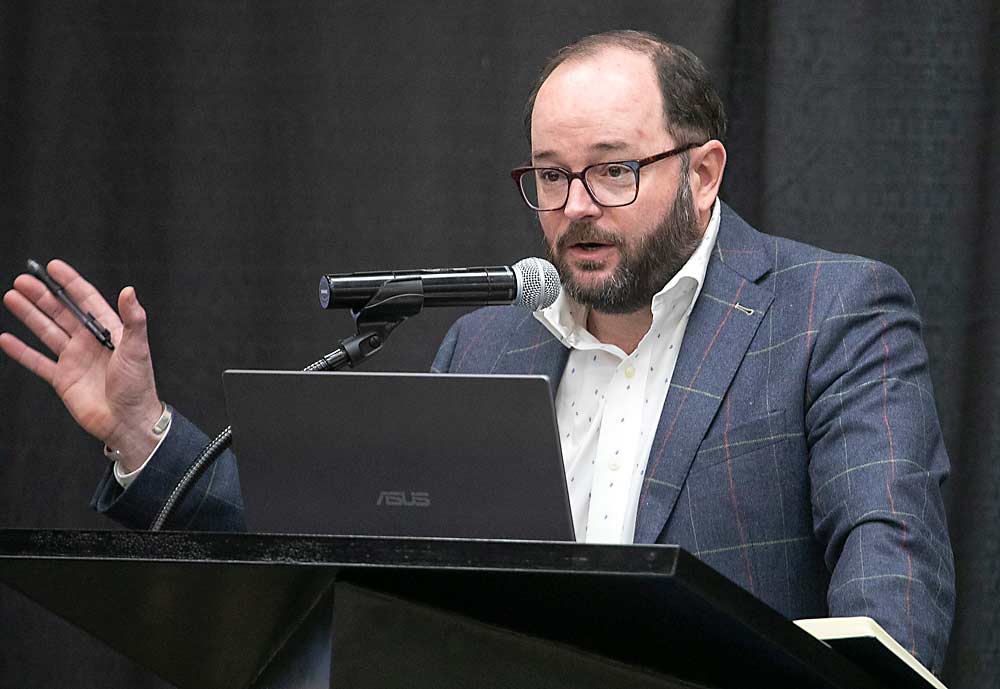
Across the U.S., the volume of wine sold is declining year over year, Thach said, though the value of those bottles is increasing slightly. Wine tourism is down, too, along with direct-to-consumer sales. The only bright spot: ready-to-drink sales, which have doubled in the past year.
Washington wine accounts for just 3.6 percent of U.S. wine production, by dollar share. The industry aims to grow that to 5 percent over the next five years, Kelley said.
To do that — as Washington’s largest winery, Ste. Michelle Wine Estates, cuts back — will require more midsize wineries pushing into the national market. Direct-to-consumer sales help to keep many small wineries profitable but play a small role in the big picture. While lower-value wine consumption is declining, there is growth opportunity, Kelley said, in the premium category. She cited strong growth in the $15–$25 and $25–$40 categories and new efforts by the commission to help wineries work with distributors.
McLaughlin agreed that the premium category presents opportunity for Washington.
“We can do the $15 to $30 range better than anyone else in the world,” he said. Several midsize wineries are already finding success in that market, nationally, he said, and there’s room for more to follow that model.
The $15–$30 range also returns sustainable margins to growers, McLaughlin added, as growers face rising input costs but stagnant prices due to the oversupply.
Going over and under
Schulz estimated Washington’s current oversupply at around 20 million gallons, with about 12 million of that from the 2022 vintage.
“Collectively, I think we made great decisions in ’23,” including growers who walked away from fruit, Schulz said. “What we are going to run up against is tank space.”
Unsold wine suppresses the value of everything else, and large wine producers are no longer coming to the rescue.
“How do we have a giant surplus and still tell the market to value what we have?” he asked.
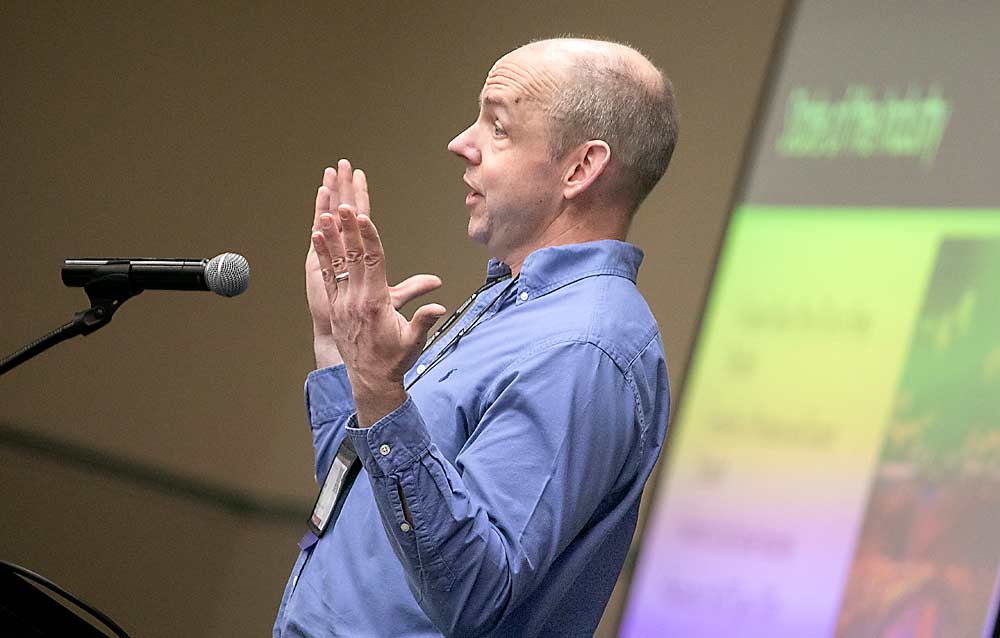
The same goes for California, where industry leaders are recommending the removal of 30,000 acres. Schulz said he’s heard people say that up to 100,000 acres could be pulled out — and no one would miss them. In Washington, removing 10,000 acres, as the Washington Winegrowers Association has estimated, would represent about 10 million gallons of wine, assuming 6 tons per acre, Schulz said.
“So much of the volume in our state is under $15 a bottle. There are so many other options on the market that the consumer has right now; we’re not seeing the level of demand for the low-price demand,” he said.
The inverse of oversupply is underdemand, McLaughlin said, and looking at the problem that way can open up new solutions.
Building demand is typically seen as the provenance of wine sellers, but in Washington, speakers said, growers have a role to play. Unlike other regions, Washington has lots of small wineries and big growers.
To find homes for all the grapes Washington currently grows, some of those growers will need to go vertical and launch their own brands or create new partnerships, McLaughlin said.
Schulz also urged growers to consider investing in solutions, citing cooperatives such as Welch’s and the wine cooperatives common in Italy that help growers manage supply and demand. Alternative uses for the juice, such as distillation, could be an option.
“All of the big, successful California wine companies have distillation lines,” Schulz said, adding that those help them play both sides of the market. “How do we move forward? We need to get together and get creative.”
Wine trends and opportunities
Kelley pointed to the Sustainable WA certification program as a bright spot in building new opportunities for Washington wine, both in opening doors with distributors and reaching younger consumers who are not loyal wine drinkers.
“We think sustainability will grow in relevance and is key to some of these anti-alcohol pressures,” she said. “Sustainable WA is a good way to get in front of those pressures.”
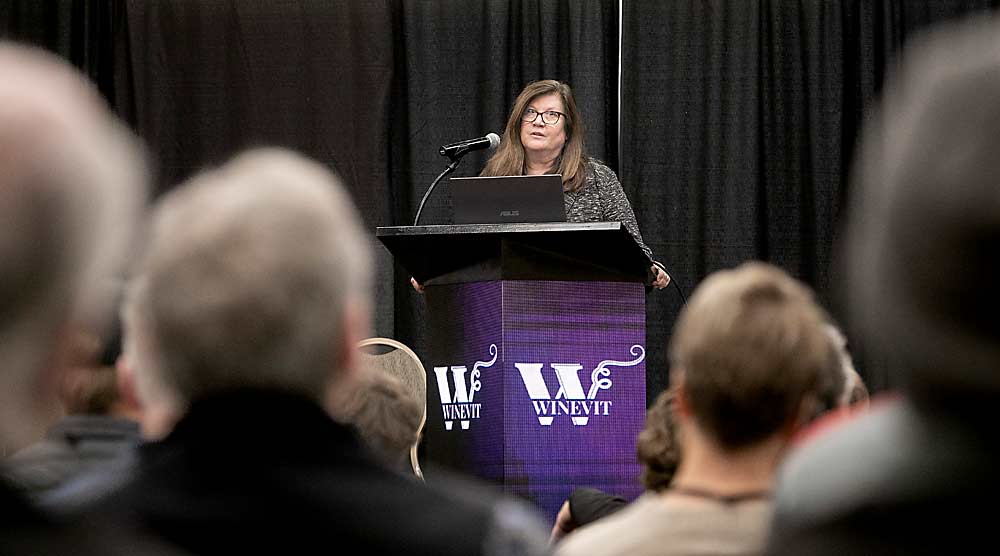
Younger consumers are more likely to believe that drinking alcohol is bad for their health, said Thach.
“Ten thousand Gen Z turn 21 every day,” she said. “They care about the climate and social responsibility.”
Right now, those young people — soon to represent a quarter of drinking-age Americans — only drink 9 percent of the wine.
She encouraged everyone in the wine industry to respect the health and wellness trends that are pushing some consumers away from wine and other alcoholic beverages. But consumer surveys show that wine is generally considered a more moderate option, and marketing can lean into that.
“Say on the label that the wine has no sugar added, say it’s vegan-friendly, say it’s locally made, say it’s a family business,” she said.
To make wine more accessible to more consumers, Thach also recommended wineries include a low-alcohol wine, sweet wines and wine cocktails on their tasting room menus — maybe even a nonalcoholic wine.
To entice those new consumers, wineries need to communicate their sustainability practices and hire more diverse people, she said.
Throughout the talks, speakers shared many trends and statistics. But there’s one number they warned against.
“Of all types of statistics, the most misleading is the average, especially with a diverse set of input data,” McLaughlin said. “We need to reject that narrative that Washington wine on average is in decline.”
—by Kate Prengaman
WineVit opens with a discussion on diversity in the wine industry
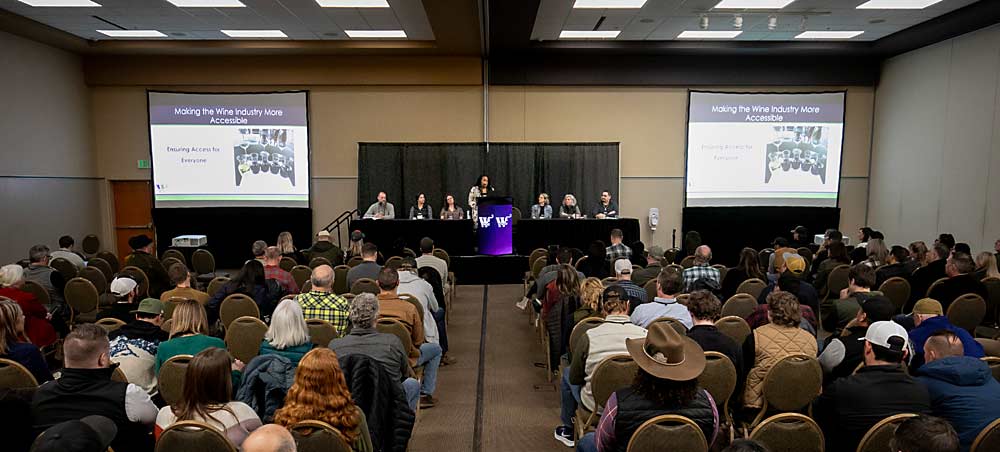
Who are the wine drinkers of the future? Who are the future workers — at every level — to drive success? Almost certainly, it’s going to be a more diverse community than in the industry’s past.
“More people of color are entering the wine industry from all access points,” said Lakaya Renfrow, a consultant for the Washington State Wine Commission. But they need to feel a sense of belonging to stick around, she added. “I tend to frequent businesses where I feel seen, heard and valued.”
The increasing diversity in the younger generations in the U.S. creates opportunities but also requires the Washington wine industry to look at the barriers that have kept some people of color from seeing themselves in the industry. Renfrow moderated a panel discussion on this topic to kick off WineVit, the annual convention organized by the Washington Winegrowers Association.
Panelists included Todd Newhouse of Upland Vineyards, Devyani Gupta of Valdemar Estates, Sadie Drury of North Slope Management, Ashley Trout of Vital Winery, Rosanna Lugo of Seven Hills Vineyard and Victor Palencia of the Palencia Wine Co.
They discussed strategies to recruit and retain a diverse workforce and appeal to more consumers.
“It’s about moving away from the idea that wine is for snobby old men,” Drury said. “Wine is a place to gather with food and friends.”
That idea of gathering and celebrating resonates across cultures, Palencia said. His winery leans on alternative distribution channels, such as community festivals, to introduce people to wine. Wineries don’t always think of Latinos as a big customer base, but wine goes great with carne asada, he said.
“We’re constantly thinking outside the box. We make it fun,” he said.
Having a diverse and welcoming tasting room staff can help customers feel comfortable and feel that wine is accessible to them, panelists agreed.
Newhouse encouraged industry employers to look at DEI efforts — which stands for Diversity, Equity and Inclusion — as more than “a bunch of letters.”
“If we want this industry to thrive, it’s going to have to be more than predominantly male and white. We need to have more people of color in our industry,” he said.
Industry honors
At the Leadership and Legacy luncheon, the annual awards were presented by friends of the honorees.
Kari Smasne, manager of the Sustainable WA program, presented the Erick Hanson Memorial Grower of the Year Award to Carly Faulk, vineyard manager at Four Feathers.
“She has done a remarkable job with the new sustainability program and has really been involved asking questions, making sure she has covered everything,” Smasne said.
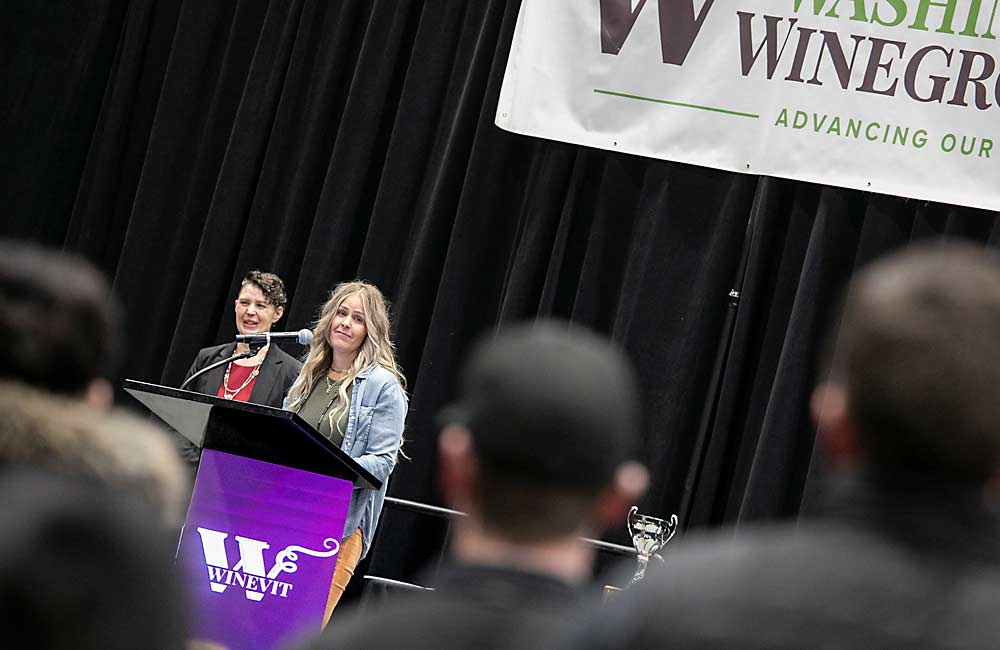
Faulk, who started her wine industry career at 18 putting bottles in cases at Hogue Cellars in Prosser, thanked all of her mentors and supporters.
“I’ve worked in some of the greatest vineyards in this industry,” and learned from so many people, she said.
Longtime winemaker Cheryl Barber Jones presented the Grand Vin award to her friend, Kay Simon, winemaker and co-owner of Chinook Wines in Prosser. After starting her career at Ste. Michelle Wine Estates, Simon founded Chinook Wines with her husband in 1983, when Washington had fewer than two dozen wineries.
Barber Jones praised Simon’s extraordinary winemaking talent, yes, but also her partnership, mentorship and service to the industry. Simon is “committed to helping the industry be the best,” she said.
Dustin Tobin of Winemakers LLC presented the Industry Service Award to Jack Maljaars, the owner of Vine Tech Equipment.
“He grew his company into a leading force in the industry and is the innovator and brains behind it all,” Tobin said. “He always wants more collaboration. He knows everyone has something to add to the industry, whether knowledge, skill, time or passion.”
Two Lifetime Achievement awards were presented posthumously to men who played instrumental roles in the growth of the Washington wine industry. The awards were presented by longtime colleagues and friends.
First, Mike Januik shared a tribute to the late Dick Shaw, founder of Shaw Vineyards. Shaw began his wine industry career with an investment in a 100-acre vineyard planting on the Wahluke Slope in 1981. He and his wife, Wendy, grew their business to over 3,000 acres. But in his own early years, when it took creativity and tenacity to build a wine business, Januik said Shaw stepped in to help him in a big way.
“He made it possible for us to do what we were doing and continue to survive,” he said. That’s how he treated people his whole career, he added.
Shaw’s wife, Wendy, accepted the award on his behalf, saying that if “Dick were here, he would say, ‘What’s this for? I’m just getting started.’”
Then, Rob Griffin, co-founder of Barnard Griffin Winery in Richland, shared a tribute to his neighbor, Jerry Bookwalter, the longtime manager for Sagemoor Vineyards and founder of J. Bookwalter Winery.
When Bookwalter, a California native, moved to Pasco to work for Sagemoor in 1976, the Washington wine industry was small, and everyone was learning from each other. Bookwalter was a key hub in that web of information, Griffin said.
“His attitude was that things can always be improved. He was forever facilitating new methods of trying to produce grapes to suit each customer,” Griffin said. “This talented, generous, kind and hardworking man will be missed by many. We are grateful for the lasting legacy he left on our lives and the industry.”
Lastly, the Washington Winegrowers staff surprised longtime executive director Vicky Scharlau with an award to thank her for her years of service, as she steps down into an of-counsel role.
“This has been an honor for me,” she said.
—by Kate Prengaman






Leave A Comment